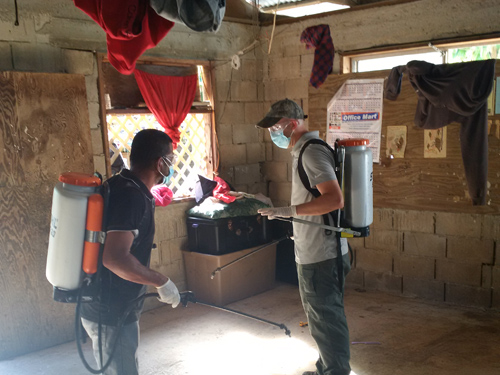Strategic National Stockpile Responders
About CDC

During the early stages of the response, stockpile personnel worked with its contract staff to rapidly assemble and ship an initial 5,000 Zika Prevention Kits to areas with known Zika virus infections.
Rather than providing medicines and supplies on hand, stockpile responders contributed specialized expertise and knowledge of medical logistics and supply chain operations in support of the Zika response.
During the Zika virus outbreak that emerged in early 2016, CDC’s Strategic National Stockpile—the nation’s largest repository of medicines and supplies for use in public health emergencies—stepped outside of its traditional role and helped CDC’s agency-wide response to Zika in a new way. Rather than providing medicines and supplies on hand, stockpile responders were tapped for their specialized expertise and knowledge of medical logistics and supply chain operations in support of the response.
During the early stages of the response, stockpile personnel worked with its contract staff to rapidly assemble and ship an initial 5,000 Zika Prevention Kits to areas with known Zika virus infections, including American Samoa, Puerto Rico, and the U.S. Virgin Islands. The kits, intended to help pregnant women protect themselves from Zika virus, consisted of a tote bag containing insect repellent approved by the Environmental Protection Agency (EPA), a mosquito bed net, condoms, and standing water tablets to kill mosquito larvae. These items were either procured by the stockpile or donated through the CDC Foundation.
By September 2016, the stockpile had assembled and delivered nearly 15,000 kits to 8 jurisdictions: Puerto Rico, U.S. Virgin Islands, American Samoa, Palau, Republic of Marshall Islands, Federated States of Micronesia, Commonwealth of Northern Mariana Islands, and Guam. Overall, approximately 31,000 kits have been distributed along with 10,000 EPA-approved insect repellents to Texas and 10,000 to Florida.
The work did not stop with simply assembling and delivering prevention products, however. Stockpile experts engaged with the General Services Administration to arrange for Zika Prevention Kits to be added to disaster response schedules. Going forward, affected jurisdictions, including those in the continental United States, can purchase and distribute kits to their populations using their grant funding, which will provide them quicker access to critical preventative measures and supplies to help curb the spread of the Zika virus.

Through the management of commercial contracts, the stockpile also oversaw mosquito spraying for more than 9,000 residential homes, hospitals, schools, and churches across the affected jurisdictions.
Through the management of commercial contracts, the stockpile also oversaw mosquito spraying for more than 9,000 residential homes, hospitals, schools, and churches across the affected jurisdictions.
The mosquito control work presented its own challenges, however. In the Republic of the Marshall Islands, for instance, a lack of street addresses or street names made it difficult to identify homes that needed spraying services. As a solution, the stockpile partnered with the ministry of health and a local hospital to use “zone nurses.” These nurses, equipped with lists of pregnant women in the area, used latitude and longitude to plot direction using a Google Earth map to locate homes. Armed with this information, stockpile personnel and mosquito control contractors successfully conducted interior and exterior spraying as a preventative measure for these pregnant women and their families.
Overall, this response took 22 stockpile personnel to U.S. territories, including Puerto Rico, the U.S. Virgin Islands, Guam, and the Republic of the Marshall Islands, to provide on-the-ground support for Zika prevention, including management of mosquito spraying contracts. In total, 68 staff members worked both in the field as well as behind the scenes at headquarters to support logistics, finance, science, and warehouse shipping and distribution.